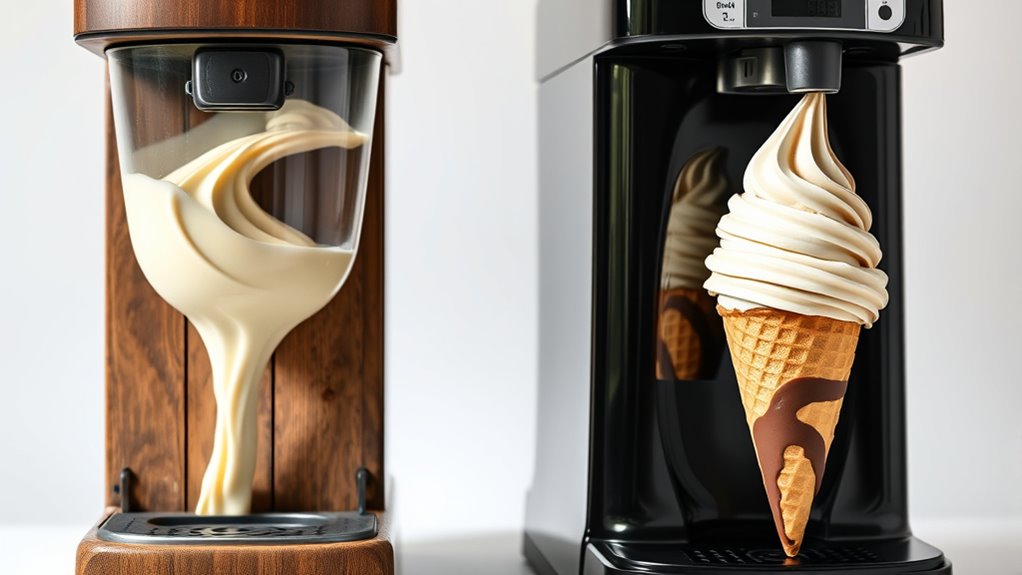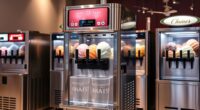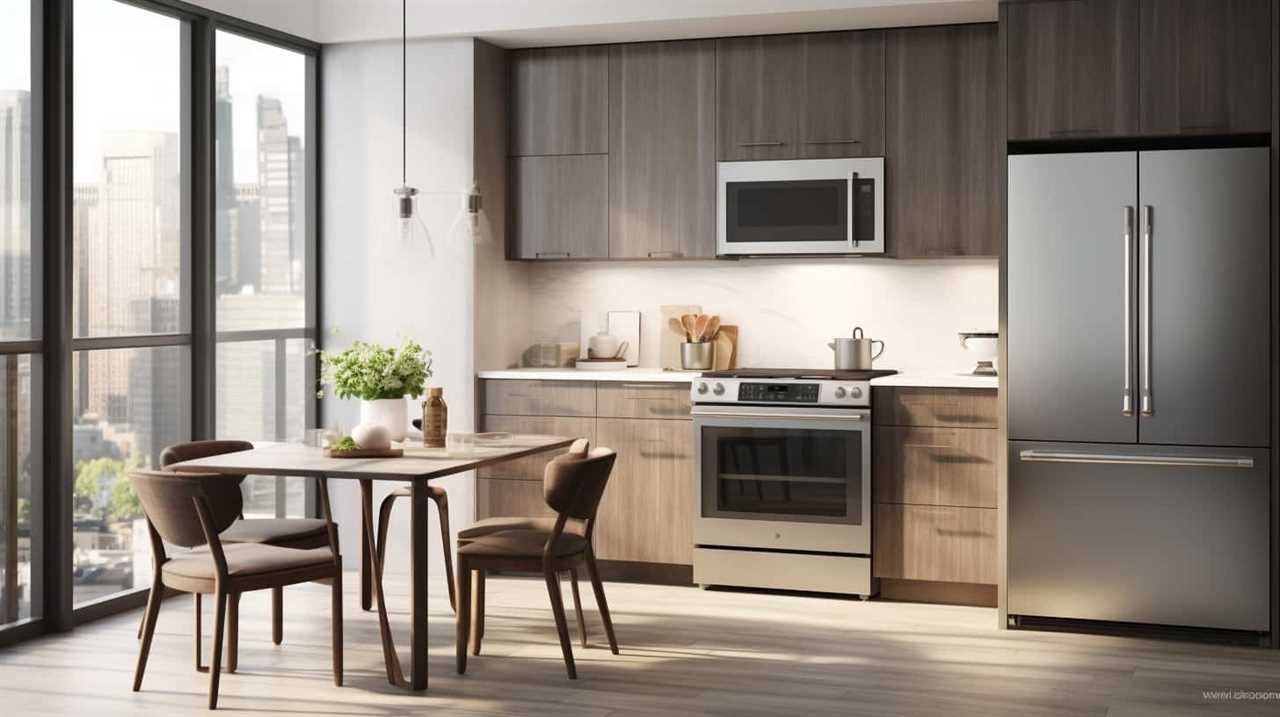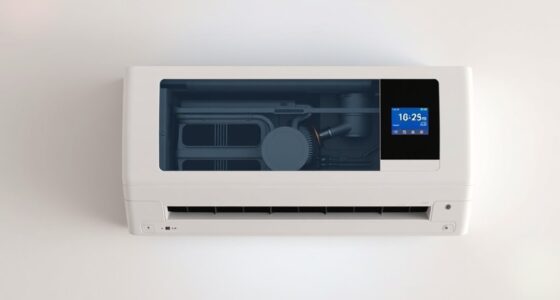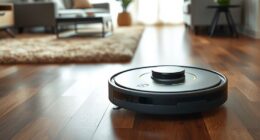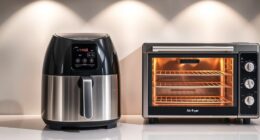If you want consistent flavor, lower maintenance costs, and steady performance, gravity-fed soft serve machines are typically more profitable over time. They are simpler to operate, require less repair, and guarantee reliable quality for your customers. While pressurized machines can handle high volumes quickly, they often come with higher maintenance and repair costs. To discover which system aligns best with your business goals and maximizes your profits, explore the details behind each option.
Key Takeaways
- Gravity-fed machines generally have lower initial and maintenance costs, improving profit margins over time.
- Pressurized models can handle larger volumes quickly, increasing throughput during busy periods.
- Consistent flavor and quality with gravity-fed systems reduce customer complaints and boost repeat business.
- Higher maintenance complexity of pressurized machines may lead to increased downtime and repair expenses.
- Overall, gravity-fed systems often offer a better balance of reliability, quality, and cost-efficiency for steady profits.

When choosing a soft serve machine, understanding the differences between gravity-fed and pressurized models can markedly impact your results. These distinctions influence not just the quality of your ice cream but also your operational costs and profit margins. Gravity-fed machines rely on gravity to dispense ice cream, allowing the mix to flow downward from a hopper into the freezing chamber. These models tend to be simpler, with fewer moving parts, which often translates into lower maintenance costs. Because gravity-fed systems typically operate at a consistent flow, they are known for delivering excellent flavor consistency, ensuring each serving meets your standards. This reliability can enhance customer satisfaction, leading to repeat business.
Gravity-fed soft serve machines offer reliable flavor consistency with simpler design and lower maintenance costs.
On the other hand, pressurized soft serve machines use a high-pressure system to push the mix into the freezing cylinder. This setup can offer advantages in terms of efficiency and speed, especially during busy periods, because it can handle larger volumes more quickly. However, pressurized models often require more complex components such as pumps and seals, which can increase maintenance costs over time. These parts are more prone to wear and tear, and troubleshooting issues can be more involved, leading to potential downtime and additional expenses. When it comes to flavor consistency, pressurized machines can sometimes be less reliable, as variations in pressure or equipment calibration might affect the texture and taste of the ice cream, especially if not properly maintained.
Financially, gravity-fed machines tend to be more cost-effective initially and over the long run due to their simpler design and lower maintenance requirements. Their durability means fewer repairs and less downtime, keeping your operation running smoothly. While pressurized machines might offer the benefit of faster service during peak hours, the higher maintenance costs and potential for inconsistent flavor could offset those gains. If your goal is steady, high-quality servings that keep customers coming back, gravity-fed models often provide a better balance of flavor consistency and operational costs.
Ultimately, your choice should align with your business’s volume, budget, and customer expectations. If you prioritize ease of maintenance, reliable flavor, and lower ongoing costs, a gravity-fed machine is generally the smarter investment. Conversely, if you need rapid service capacity and are prepared to handle more complex maintenance, a pressurized model might suit your needs better. But for most operators focused on consistent quality and minimizing expenses, gravity-fed soft serve machines deliver a compelling combination of dependability, flavor, and profitability.
Frequently Asked Questions
Which Soft Serve Machine Type Requires Less Maintenance?
When choosing a soft serve machine, you might wonder which requires less maintenance. Generally, gravity-fed machines tend to be simpler, with fewer moving parts, making them more durable and easier to maintain. They also offer good flavor versatility without complex components. Pressurized machines, while versatile, often demand more upkeep due to their additional parts and pressure systems. So, if low maintenance and durability are your priorities, gravity-fed models are usually the better choice.
How Does Machine Size Impact Profit Margins?
You should consider how machine size impacts profit margins because larger machines often cost more upfront and require more space, which can increase your expenses. Smaller machines might have lower initial costs and fit better into limited spaces, potentially boosting profit margins. However, they may also produce less soft serve per hour. Balance your needs, space, and expected sales to choose a machine size that maximizes your profit margins.
Are There Specific Flavors Better Suited for Each Machine Type?
Sure, you’re wondering if some flavors play favorites with certain machines. Well, guess what? Gravity-fed machines excel with classic, scoopable flavors thanks to their simplicity, while pressurized systems thrive on rich, customizable options that need precision. Flavor versatility often depends on your desire for customization options; some flavors are better suited for each machine type, letting you serve up unique treats while maximizing profits. Choose wisely, and your customers will thank you.
What Are the Initial Setup Costs for Gravity-Fed Versus Pressurized Systems?
When comparing initial setup costs, you’ll find that gravity-fed systems generally require a lower investment, making them less risky for beginners. Pressurized systems tend to be more expensive upfront due to additional equipment and installation complexity, increasing your investment risks. Consider your budget and long-term goals carefully, as the cost comparison impacts your overall profitability and ease of operation. Choosing the right system depends on balancing initial costs with your business needs.
Which System Offers Faster Service During Peak Hours?
During peak hours, the pressurized soft serve system typically offers faster service because it delivers a consistent flow of ice cream, reducing wait times. This improved speed of service can boost customer satisfaction, as patrons appreciate quick, efficient service. By minimizing delays, you create a smoother experience, encouraging repeat visits and positive reviews. Overall, a pressurized system can help you handle busy periods more effectively, leading to happier customers and increased sales.
Conclusion
Ultimately, choosing between gravity-fed and pressurized soft serve machines depends on your goals and setup. Both can be profitable if you play your cards right, but understanding their strengths helps you make the best call. Don’t put all your eggs in one basket—consider your space, budget, and customer experience. Remember, a well-informed decision today can pay off in the long run, so don’t leave money on the table by rushing into it.
